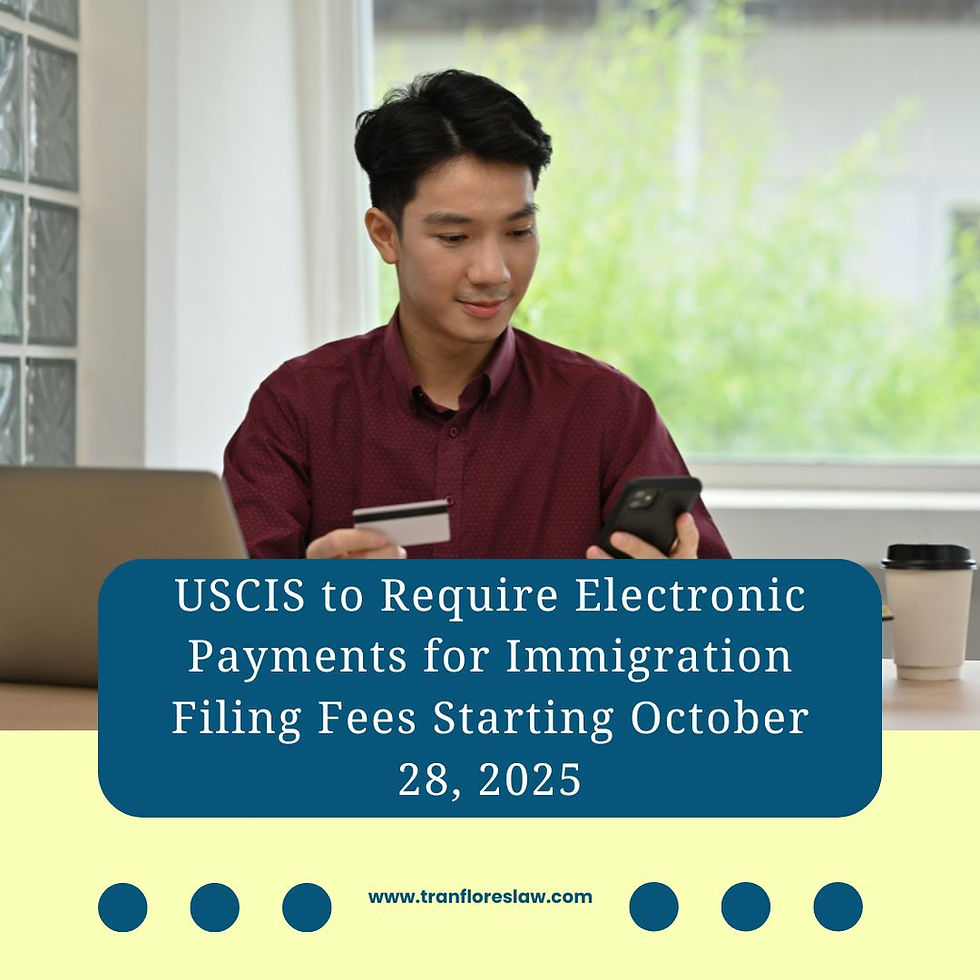USCIS to Require Electronic Payments for Immigration Filing Fees Starting October 28, 2025
- Thong Le
- Sep 17
- 3 min read

Starting this fall, paying your immigration filing fees will look very different. U.S. Citizenship and Immigration Services (USCIS) has announced that, effective October 28, 2025, the agency will only accept electronic forms of payment. This is a major shift for applicants and petitioners who have traditionally relied on checks or money orders to pay filing fees.
What’s Changing?
Until now, USCIS has allowed several payment methods, including checks, money orders, credit cards, and debit cards. But under the new policy, paper-based payments like checks and money orders will no longer be accepted. Instead, applicants must pay using one of two electronic options:
Form G-1450, Authorization for Credit Card TransactionsThis form has been available for years and allows you to authorize USCIS to charge your U.S.-issued credit or debit card.
Form G-1650, Authorization for ACH TransactionsNewly introduced, this form allows applicants to pay directly from a U.S. bank account using an ACH (Automated Clearing House) debit transaction. Think of it like an electronic check — but instead of mailing paper, the payment is processed instantly through your bank.
What About Exceptions?
There are limited circumstances where applicants may be exempt from the electronic payment requirement. For these situations, USCIS has created:
Form G-1651, Exemption for Paper Fee. This form must be submitted if you qualify for an exemption that still allows you to pay with a traditional paper check or money order. However, exemptions are expected to be rare and carefully scrutinized.
Why the Change?
USCIS has explained that moving to an all-electronic payment system will:
Improve efficiency in processing applications
Reduce errors and delays caused by bounced checks or mismatched payments
Enhance security by lowering the risk of lost or stolen paper payments
From the agency’s perspective, this modernization aligns with the broader trend of government services moving online. For applicants, however, it may require adjusting to new procedures and ensuring they have access to a U.S.-issued credit card or bank account.
Applicants must also take extra care with electronic payments. USCIS may not process your payment right away. Due to backlogs, it could take weeks or even months after filing before USCIS actually charges your account. If your bank account has insufficient funds or if your credit card has expired by that time, the payment will fail. When this happens, USCIS will reject the entire application and send it back.
In cases where strict deadlines apply, such as filing before a certain age cut-off or responding to USCIS within a limited timeframe, a rejected filing could mean losing your chance to apply for the benefit at all. Careful planning of your payment method is now just as important as preparing the forms themselves.
What Applicants Should Do Now
If you are planning to file an application or petition with USCIS after October 28, 2025, here are some steps to prepare:
Check your payment options – Make sure you have either a U.S. credit/debit card or a U.S. bank account that supports ACH debit transactions.
Familiarize yourself with the new forms – Review Form G-1450 and the new Form G-1650 so you know which payment option works best for your situation.
File early if possible – If you are more comfortable paying with a traditional check or money order, consider submitting your application before the October 28 deadline.
Get professional guidance – Immigration forms are already complex, and adding new payment procedures can create unnecessary stress. Working with an experienced immigration attorney can ensure everything is filed correctly and on time.
The Bottom Line
Beginning October 28, 2025, USCIS will only accept electronic payments for filing fees, either by credit card (Form G-1450) or ACH debit (Form G-1650). Paper checks and money orders will no longer be accepted unless you qualify for a narrow exemption through Form G-1651.
If you are preparing to file with USCIS, it’s important to plan ahead and avoid costly mistakes. Our attorney at Tran Flores Law can help you navigate these changes and ensure your application is submitted smoothly. Call us today at (512) 894-9984 to schedule a consultation.




Comments